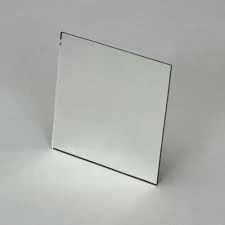

The Intricacies of Dead Flat Float Glass
In the world of architectural and design materials, few products embody purity and utility as profoundly as dead flat float glass. This specialized type of glass is renowned for its uniform thickness, optical clarity, and absolute flatness, making it indispensable in a myriad of applications ranging from windows to intricate artistic installations.
What is Dead Flat Float Glass?
Dead flat float glass is a material produced through the float glass process, wherein molten glass is floated on a bed of molten tin. This manufacturing method ensures that the glass achieves a level of uniformity and an immaculate surface finish that is hard to replicate. The term “dead flat” refers to the glass’s exceptional flatness, which is crucial for applications where precision and optical clarity are paramount. Unlike regular float glass, which may have slight bowing or distortions, dead flat float glass maintains its integrity, thus providing a flawless medium for viewing and aesthetics.
Applications of Dead Flat Float Glass
The attributes of dead flat float glass make it suitable for a diverse range of applications. One of the primary uses is in the construction industry, where it forms the backbone of glass facades, windows, and curtain walls. Its exceptional clarity not only allows natural light to flood interiors but also creates a seamless connection between the indoors and outdoors.
In the realm of interior design, dead flat float glass is favored for mirrors, display cases, and glass partitions. The lack of distortions ensures that reflections are true, enhancing the beauty of spaces. Additionally, artists and designers often utilize this glass for creating stunning visual displays and modern art pieces because it can be cut, shaped, and laminated without compromising its flatness.
Furthermore, technological advancements now enable the integration of dead flat float glass with smart features such as electrochromic coatings and touchscreen interfaces, allowing for innovative designs in electronic displays, smart windows, and interactive systems
.
Advantages Over Regular Glass
Compared to regular float glass, dead flat float glass offers several advantages. Firstly, its uniform thickness reduces the likelihood of warping, especially in large panels. This characteristic is vital in applications requiring precision, such as solar panels and high-definition displays, where even minute distortions can lead to significant performance issues.
Secondly, the optical clarity of dead flat float glass is exceptional. The low levels of distortion ensure that colors and details are perceived accurately, which is particularly important in museums, galleries, and retail environments where visual presentation is key to customer experience.
Lastly, the enhanced durability and resistance to scratching associated with dead flat float glass make it a preferred choice for high-traffic areas and surfaces subject to wear and tear.
Sustainability Considerations
In an age where sustainability is paramount, manufacturers of dead flat float glass are continually seeking ways to reduce their environmental impact. Many companies are adopting eco-friendly practices, utilizing recycled materials, and optimizing their production processes to minimize energy consumption and waste. By choosing dead flat float glass, architects and designers also contribute to energy-efficient building solutions, as the glass can be treated for energy-saving insulation or UV resistance, thus enhancing overall building performance.
Conclusion
In conclusion, dead flat float glass stands as a testament to the intersection of beauty, functionality, and technology in modern design. Its unmatched clarity, uniformity, and versatility make it a staple in various sectors, greatly impacting architectural aesthetics and interior spaces. As manufacturers continue to innovate and address sustainability issues, the future of dead flat float glass looks promising, ensuring its place at the forefront of material science for years to come. Whether utilized in a high-rise building or a simple home decor piece, dead flat float glass relentlessly elevates everyday experiences through its transparent elegance and enduring quality.